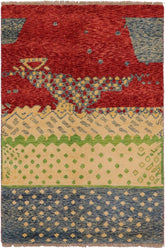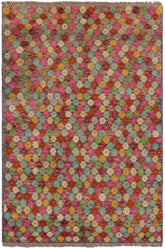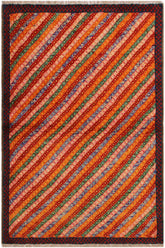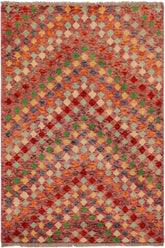Free shipping on All Orders Over $199.
Connect with us: (201) 552-2733 or info@treasureknot.com
COMMON RUG TERMS
Common Rug Terms: The Treasured Knots Glossary of Handmade Rugs
Understanding the terminology of handmade rugs is essential for appreciating their value, construction, and history. Use this comprehensive glossary from Treasured Knots to familiarize yourself with the common terms used in the world of designer rugs, Oriental rugs, and textiles.
|
Term |
Definition & SEO Key Insights |
|
Abrash |
The color variation or shift found in a rug, typically visible in a single color field. It is caused by the weaver changing dye lots and is considered a sign of authenticity in vegetable-dyed handmade rugs. |
|
Age |
Refers to how old a handmade rug is. Categories include: Antique (60-plus years), Semi-Antique (25 to 60 years), and Contemporary (less than 25 years). |
|
Antique |
A vintage rug that is at least 60 years old, often highly valued. |
|
Braid |
The three or more strands of material (e.g., wool or rag strips) laid over each other in a diagonal overlapping pattern before being sewn into a rug. |
|
Chrome Dyes |
Synthetic, highly colorfast products developed between WWI and WWII for dyeing rug yarns. |
|
Cotton |
Natural material used primarily for the warp and weft (foundation) of many Oriental rugs. |
|
Curvilinear |
Literally curved lines. A pattern style featuring intricate swirls, arcs, and bows, common in formal Persian rugs. |
|
Dye |
The process of coloring fibers (wool, silk, cotton, or synthetic). Dyes may be natural (plant-based) or synthetic. |
|
Flat Weave |
A major rug weave where the weft strands are passed over and under the warp strands. No pile or knots are used (e.g., Kilims). |
|
Foundation |
The entire structural base of a rug, made up of the interwoven warp (vertical) and weft (horizontal) threads before the knots or pile are introduced. |
|
Fringe |
The extension of the warp threads beyond the main body of the rug. It is an integral part of the hand-knotted rug's structure, not just a decoration. |
|
Geometric |
Rug patterns based on simple, symmetrical shapes such as lines, triangles, squares, and rectangles, common in tribal rugs. |
|
Hand-knotted |
The most valued rug construction technique where a short piece of yarn is individually tied around two neighboring warp strands, creating a durable pile surface. |
|
Hand-Tufted |
A faster, non-knotted rug weave. Tufts or loops of yarn are pushed through a primary backing material. |
|
KPSI / Knot Count |
KPSI (Knots Per Square Inch): The number of knots found within one square inch of a rug. Higher knot counts indicate greater detail, higher quality, and increased durability. |
|
Loom |
The frame (vertical, horizontal, fixed, or mobile) that holds the warp strands taut during rug weaving and knotting. |
|
Nap |
The direction of the pile. Affects the color and sheen when viewed from different angles. |
|
Natural Dyes |
Coloring agents extracted exclusively from plants, animals, and minerals; often favored for their subtle variations and aging properties in antique rugs. |
|
Pattern |
The arrangement of the yarns. Classes include Pictorial, Geometric, and Curvilinear. |
|
Pictorial |
Patterns that portray specific subjects, such as people, animals, and scenes. |
|
Pile |
The surface material (fiber) used for weaving handmade rugs. Wool, silk, and cotton are common natural fibers. |
|
Pile Height / Thickness |
The length of the fibers (pile), determining if the rug is low-pile or deep-pile. Affects the feel, style, and cleaning requirements. |
|
Pile Weave |
The technique where yarn is knotted around warp strands to create the surface pile. |
|
Runner |
A long and narrow rug designed for use in high-traffic areas like hallways, stairways, and entrances. Also called a corridor rug. |
|
Selvedge (or Selvage) |
The finished, reinforced edges that run along the length of the rug (parallel to the warp). It prevents the rug from unraveling horizontally. |
|
Silk |
An expensive, luxurious fiber made from silkworms; often used for highlight details in fine hand-knotted rugs. |
|
Synthetic Dyes |
Chemically derived coloring agents, widely used since the mid-nineteenth century. |
|
Textile |
Simply a woven or knit cloth. |
|
Warp |
The lengthwise yarns (the ones attached to the loom) that form the structural foundation of the rug. |
|
Weave |
The process of making rugs on a loom by interlacing warp and weft yarns. Techniques include Pile Weave, Flat Weave, and Hand Tufted. |
|
Weft |
The crosswise or horizontal yarns manipulated by the weaver; essential for holding the knots in place. |
|
Wool |
The fine, soft hair from sheep. The most common and durable pile material used in high-quality handmade rugs. |
|
Yarn |
A continuous strand of twisted threads of natural or synthetic material used in rug making. |
- Choosing a selection results in a full page refresh.

















